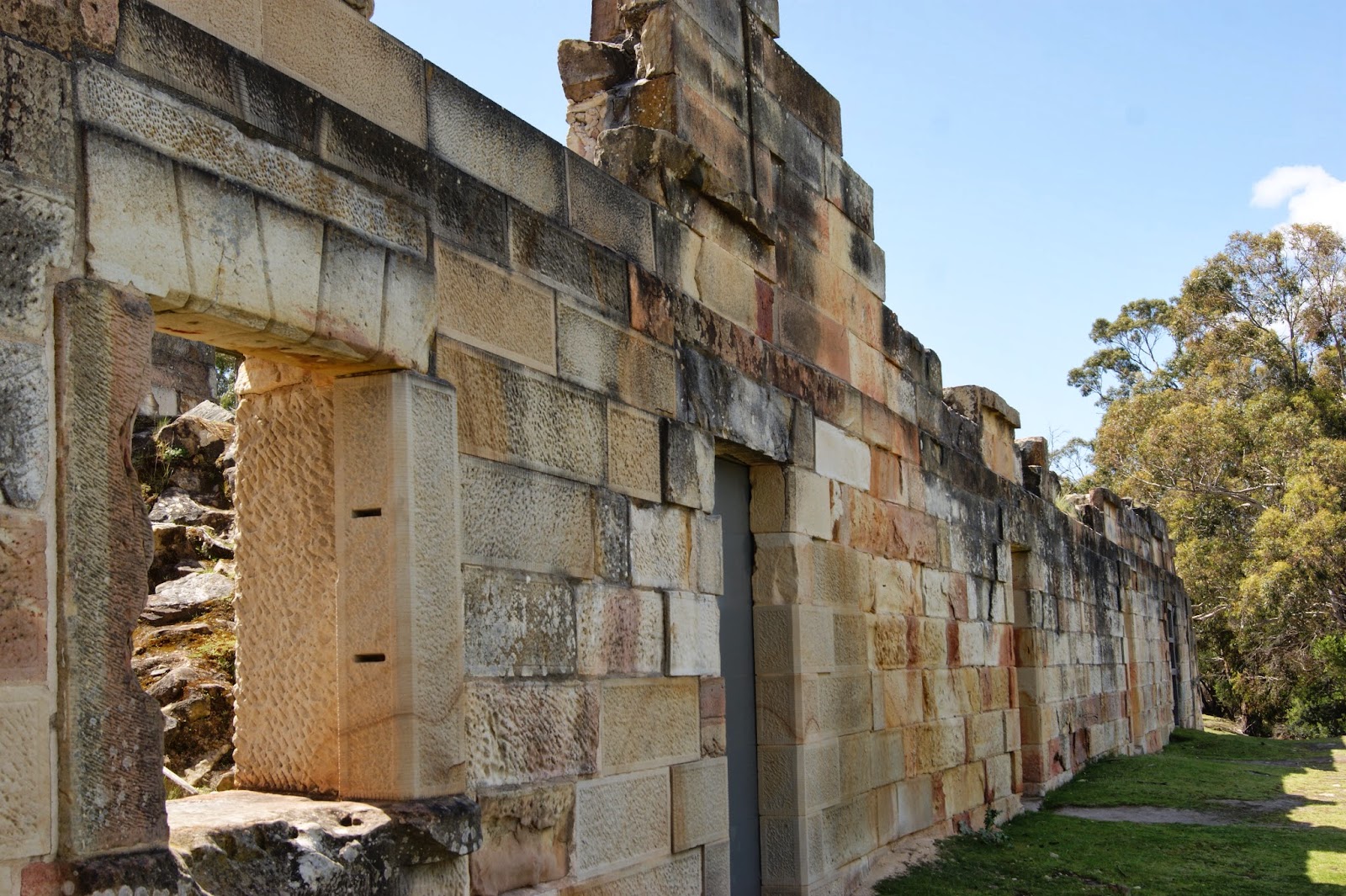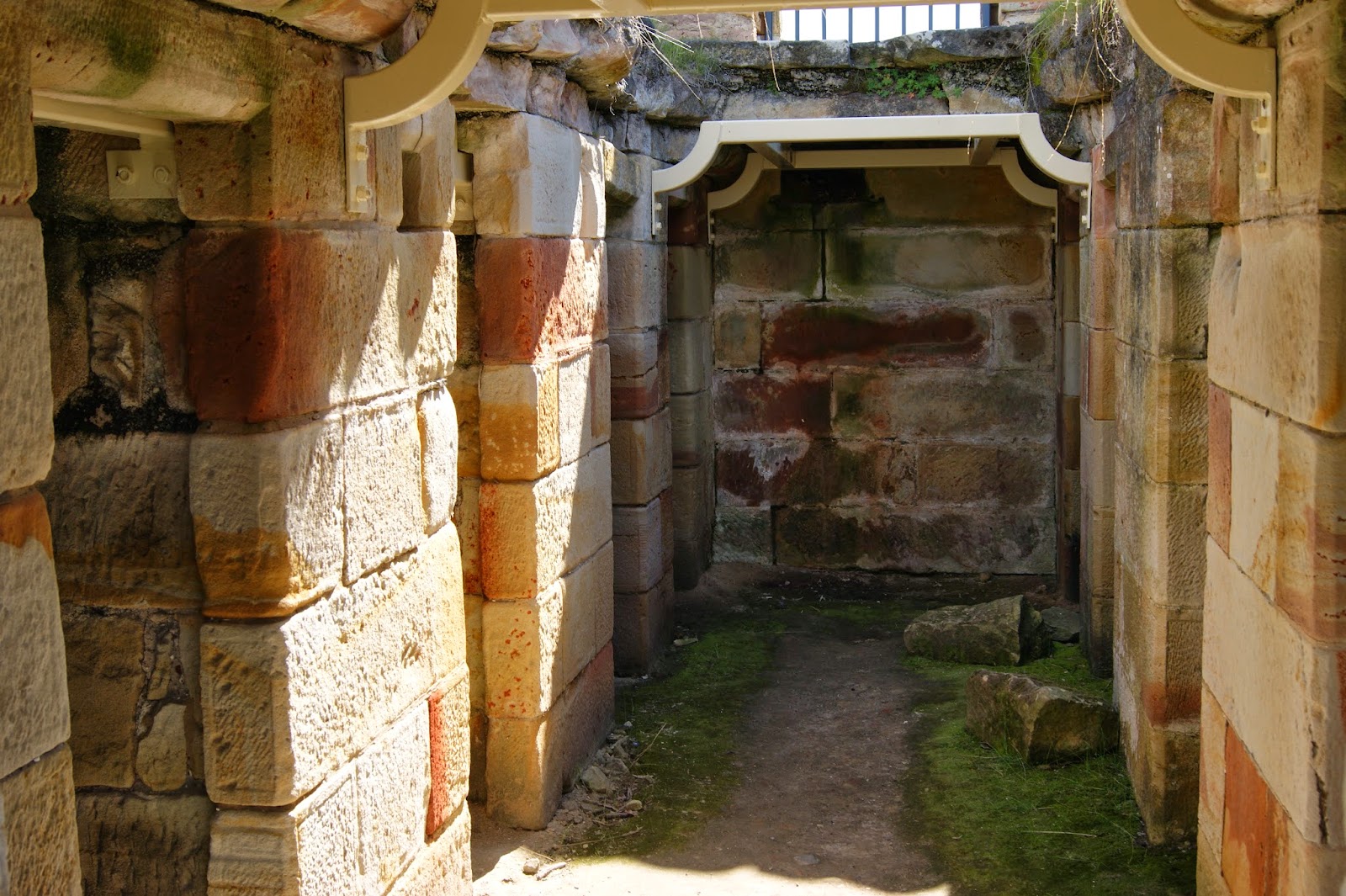Located in bushland on the northern promontory of Tasman Peninsula, beside the tranquil waters of Little Norfolk Bay, the Coal Mines Historic Site contains a collection of ruins and landscape modifications that tell the story of a convict establishment and penal colliery that operated from 1833-48. It is one of several probation stations established on the Tasman Peninsula to exploit the natural resources and provide for the reform of convicts through hard labour in a secure and isolated landscape. Not only was the Tasman Peninsula selected for its isolation, but the Coal Mines themselves were isolated from the main settlement at Port Arthur.
The main settlement is in a concentrated area between Coal Mine Hill and an inlet of Norfolk Bay. At its peak it held up to 500 convicts as well as officers, guards and their families. Coal was an essential fuel and an important prerequisite for a functioning economy and since only small quantities were found up to 1833, the discovery and subsequent exploitation of the Coal Mines was of considerable importance.
Coal was discovered on the Tasman Peninsula coast near Plunkett Point in 1833 by two government surveyors, Woodward and Hughes as a seam 2 m thick. The discovery of the coal deposit not only had the potential to supply the needs of the colony but also provided the administration with a way of punishing rebellious convicts. Not long after the discovery, a small group of miners, supervised by the convict Joseph Lacey, began work at the site. Joseph Lacey, a convict with practical mining knowledge, was sent with a small party of convict laborers to commence the work in 1833.
By 1839 the Coal Mines employed 150 prisoners and a detachment of 29 officers was stationed at the mines. The layout of the Coal Mines settlement represents a planning hierarchy typical of convict stations with the security of troops and stores paramount. Large stone barracks, erected in 1838, housed up to 170 prisoners and was built within a fenced compound.
Underneath the convict barracks were 16 solitary cells which meant the early timber punishment cells within the mine working were then little used. The Chapel/schoolhouse sat in the centre facing the courtyard wall to the north. The cookhouse, bakehouse, washroom, guardhouse and store completed the stone ensemble. These are the ruined stone buildings set in a U-shape in the main settlement. Allowing surveillance and a degree of separation, the weatherboard military barracks and more comfortable brick buildings housing the officers, surgeon and other officials such as the chaplain, were situated on the hillside above the convict compound.
By 1841 the operation was mechanised with a steam engine to pump water from the mine shafts. Machinery footings and the remains of a large boiler are evident beside the large shaft. The mines were worked by the method of leaving a column of coal to support the roof of the mine, known as the 'pillar and stall' method. Winding wheels brought up baskets of coal that were upturned into carts. A system of inclined tramways utilised the natural hills of the landscape to carry the coal from the shafts to the jetties and to the cargo vessels.
Transport to the site was by sea and extensive jetties were constructed to take the coal across the shallow waters of the bay to ships. By 1847 the main shaft was down over 300 feet and there were extensive tunnels and caverns. During the 1842-48, the 1841 (also called the 1842) shaft continued to operate and twin shafts were sunk nearby. The new shaft brought into production in 1845 was over 300ft (91.44m) deep.It was the first mechanised mine in Tasmania and sunk through rock using explosives. It had a workshop, a blacksmiths shop, a large engine complex with a boiler and self acting inclined plane. Coal production averaged 50 tons a day but by 1847, production had slumped to less than half of this amount leading to increased prices for coal in the colony. The hard labour for convicts associated with the operation of the coal mine was considered a severe form of punishment. The number of solitary punishment cells including some at the bottom of the mine shafts, and records of floggings and solitary confinements, indicate a comparatively high record of additional punishment.
The Coal Mines site was reclassified as a probation station in the early 1840s when the assignment system was abandoned. The station held up to 500 prisoners between 1841 and its closure in 1848. During this period a new Mining Superintendent reported directly to Hobart rather than to Port Arthur, although the Port Arthur Commandant remained in charge of other aspects of the settlement, including security. The probation system of convict management was unique to Van Diemen's Land and was based on the principle that punishment and reform could be achieved by hard labour, religious instruction, and education.
It was based on the concept of labour as punishment, but that this labour would be expended on public causes and the furthering of the development of the colony. Prisoners under probation, if they had mining experience, were sent to the mines. While this resulted in an increase in the skilled work force at the Coal Mines Probation Station, coal production did not increase proportionately.
Men worked for two eight-hour shifts a day in the low hot damp tunnels of the mines. Other convicts were employed in infrastructure development and the operation of the station. Quarries provided sandstone for buildings, and bricks from local clay were made and fired on site. A lime kiln, which still exists, provided lime for mortar. Shoes were made on site, and pits used for tanning leather are still evident.
After 1846 when the probation system was considered a failure, Coal Mines again became a secondary punishment station. The Coal Mines were officially closed as a probation station in 1848. The 1848-77 period marked the time when the mines were leased to private miners who still employed convicts as late as 1854. Old shafts were worked out and new shafts were sunk. By 1877 most of the field had been worked out although leases were held by prospectors until 1901. By 1900 all mining activity had ceased, the buildings were in ruins and pillaged for stone and brick.
The ruins of the mine settlement were purchased by the Scenery Preservation Board in 1938 for the creation of a public reserve. Following the creation of the reserve in 1939, the Coal Mines were virtually ignored by the SPB for over a decade. The site was extensively pillaged for bricks, cut stone and mining machinery. Although the SPB tried to appoint a caretaker during the 1960s, little was done to protect or interpret the site until 1969 when the first two interpretive signs were erected.
This significant convict site was included in the National Heritage List on 1 August 2007.
The Coal Mines Historic Site is one of 11 historic sites that together form the Australian Convict Sites World Heritage property which were officially listed on the UNESCO World Heritage List in July 2010.
The site is a wonderful place to wander at your own pace and explore the entire site, from the main ruins to officers houses nestled in the bush just off the walking tracks. This is a site that I highly recommend visiting. You get a real feel for the conditions that the convicts had to work in. If only the ruins could speak, I'm sure they'd have some awesome stories to tell!!
Main Text & Information Source: http://www.environment.gov.au/node/19642























